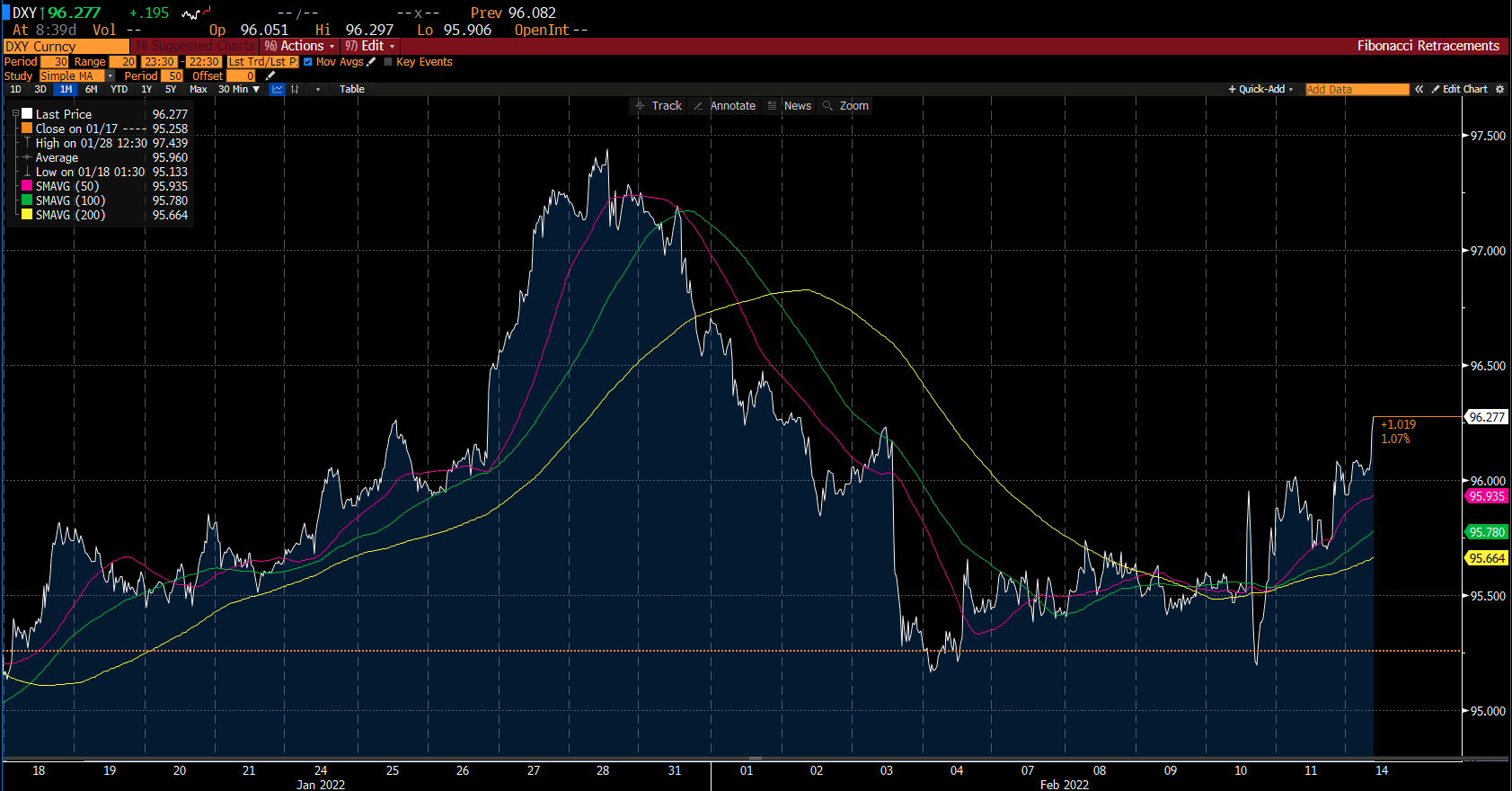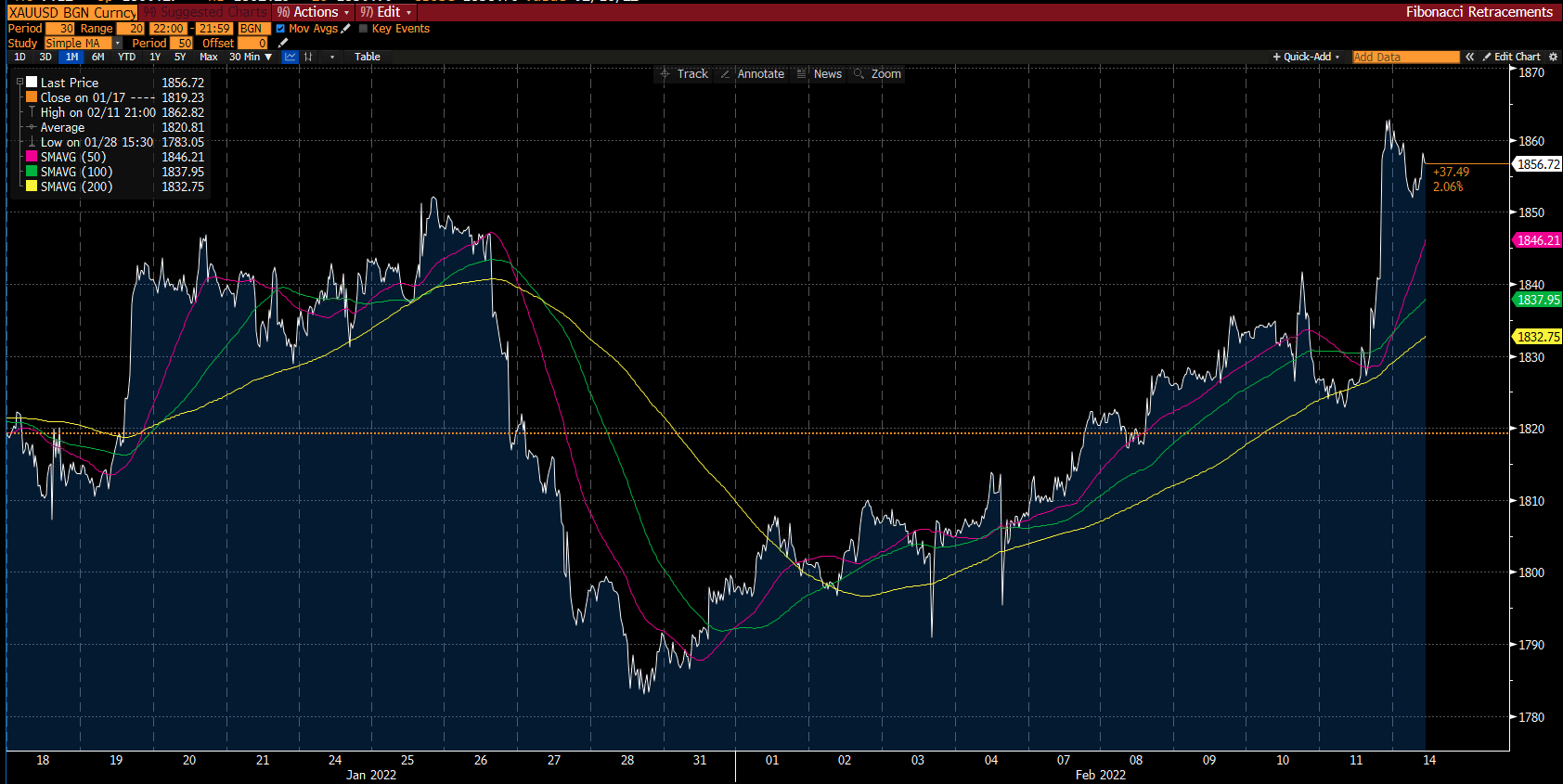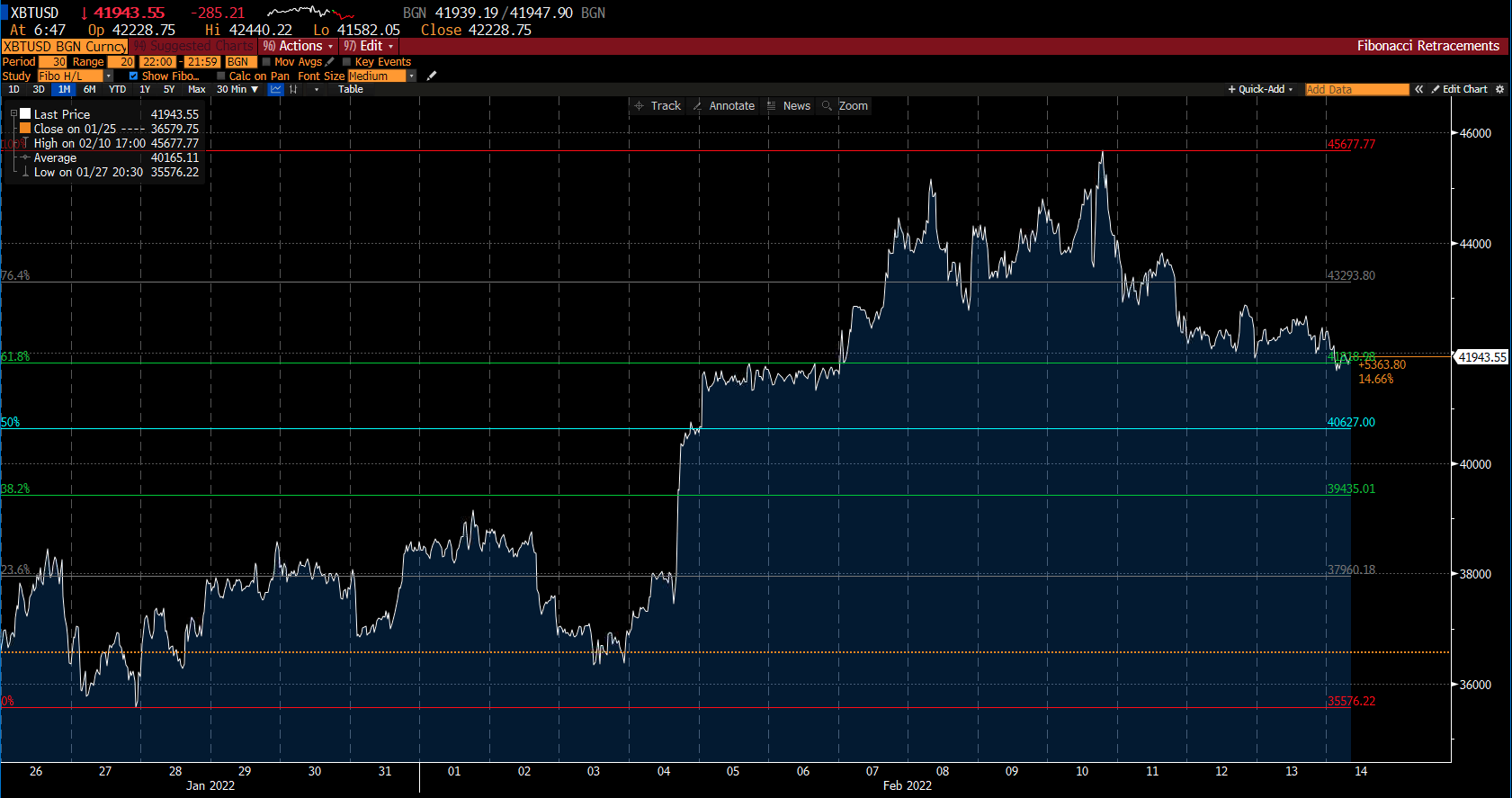Forex
Source: Bloomberg. Click to see full size
Last week, the DXY Index was up by +0.71% (close over close). This rise followed the US inflation rate data for January (CPI), which came in at 7.5% and reports that Russia is preparing to invade Ukraine. With this rise and movements in other safe-haven assets like US Treasuries and the Japanese yen, the market may be becoming increasingly concerned about a potential invasion. At the time of writing, the dollar index is trading around $92.2 and, as per the monthly charts, has multiple support levels at 50 SMA, 100 SMA and 200 SMA around $95.93, $97.78 and $95.66, respectively.
How did the other pairs react?
- The Euro depreciated, putting EUR/USD prices in jeopardy due to Russia and Ukraine’s geopolitical uncertainties. A strong US inflation report, in which the CPI hit a new 40-year high in January, pushed the EUR/USD even lower. Therefore, the likelihood of a 50-basis-point rate hike by the Federal Reserve at its March meeting has risen dramatically.
- USD/JPY surged to just a point below its five-year high. With the release of the January inflation report, Treasury yields rose sharply, sending stocks tumbling and driving the USD/JPY to ¥116.34. In the United States, interest rates have resurfaced as a major factor. Furthermore, Japan’s economic data was disappointing, with Labor Cash Earnings and Household Spending falling short of their respective predictions of 0.1% and 0.3% in December.
- The GBP/USD pair managed to keep most of its gains from the previous week. As US inflation touched a new 40-year high, the spotlight switched back to the Federal Reserve’s (Fed) tightening stance. Meanwhile, the UK economy has weathered the Omicron storm. However, due to Brexit concerns and failed attempts by the European Union (EU) and the United Kingdom (UK) to relaunch the negotiations on post-Brexit commercial relations in Northern Ireland (NI), GBP bulls have been cautious. This sentiment caused the pair to trade in the range of $1.3485 – $1.3645, despite improving fundamentals.
This week, the focus will be on the January Retail Sales – predicted to be at 1.8% MoM, the January Producer Price Index – expected to be at 0.5% MoM, and the Federal Open Market Committee (FOMC) meeting.
Commodities
Source: Bloomberg. Click to see full size
Oil prices rose for the eighth consecutive week as tensions between Russia and Ukraine raised concerns about limited global supplies. The global benchmark, WTI crude, rose just shy of $95 a barrel on Friday 11 February 2022, before paring gains.
Russia’s potential invasion of Ukraine poses a geopolitical risk that could disrupt global oil supplies and prompt US regulatory sanctions. In recent weeks, oil prices have risen due to speculation that demand will outpace supply as the global economy continues its recovery from the pandemic.
“The oil market is incredibly tight. Prices continue to surge and are now reaching levels that are uncomfortable for consumers across the world”, said Toril Bosoni, head of IEA’s oil markets division, on Friday 11 February 2022.
In the metals market, gold ended last week at its highest level in 3 months after breaking through $1,850 – a crucial resistance level. In Friday’s late session, the yellow metal caught demand as US involvement in the Russia-Ukraine crisis deepened. While the news induced selling pressures within the equity markets, gold prices were up more than 1% on the day and around 2.1% on the week.
Gold is currently trading at around $1,856 levels, well above its corresponding 50, 100 and 200-day moving averages. The latest geopolitical uncertainty, along with equity market instability and rising inflationary pressures across the US and Europe, is likely to ensure its place in traders’ portfolios for the foreseeable future.
Cryptocurrency
Source: Bloomberg. Click to see full size
Thursday, 10 February 2022, saw the price of Bitcoin fall slightly amid a more severe financial pullback in the US. On Friday, 11 February 2022, US president Biden urged all Americans to leave Ukraine immediately, warning “an invasion could begin at any time”. Furthermore, Russian and Ukrainian geopolitical risks contributed to the crypto dip and retreat to safe-haven assets.
Bitcoin surrendered most of its gains from the week’s opening as the yield on the 10-year Treasury rose to over 2% for the first time since 2019. The world’s largest cryptocurrency fell by almost 1.30% to around $44,100 levels.
In recent months Bitcoin has been trading noticeably similar to tech stocks. Last week, increasing inflation pressures pushed the 10-year benchmark higher, which negatively affected high-growth tech stocks and Bitcoin. This was because institutional traders are now interested in Bitcoin and trading it as a risk asset. As a result, the world’s largest cryptocurrency has been trading negatively along with tech stocks, which started the new year on a sharp decline.
Technically, Bitcoin is trading dangerously close to its first major support level of $41,943 at the 61.8% retracement level. If it slips through this level, the new primary support would be $40,627 at 50% retracement. Meanwhile, an upwards movement for Bitcoin would introduce $43,293 as its next resistance level at 76.4% retracement.
Most altcoins followed Bitcoin’s plunge, as Ethereum dropped by 4% on Friday, 11 February 2022, while Solana plummeted by 7%.
Analysts expect Bitcoin, the world’s largest cryptocurrency, to remain under pressure for the next few months. “In last spring’s drawdown, it took about 6 months for Bitcoin to recover. A similar timeline in the current drawdown would put a recovery date sometime in May”, wrote Bitcoin holding company NYDIG last week.
US Indices
|
Name of the index |
Friday’s close |
*Net Change |
*Net Change (%) |
|
Dow Jones Industrial (US 30) |
34,738.06 |
-353.07 |
-1.01% |
|
Nasdaq (US Tech 100) |
14,253.84 |
-317.41 |
-2.18% |
|
S&P 500 (US 500) |
4,418.64 |
-65.23 |
-1.45% |
Source: Bloomberg
*Net change and net change % are based on the weekly closing price change from Monday to Friday.
The major US market indices fell again this week, continuing with their poor start to the year. Due to increased concerns about inflation, monetary tightening, and the geopolitical turmoil in Ukraine, stocks rose on Tuesday and Wednesday before falling on Thursday and Friday.
The 10-year US Treasury yield rose above 2% for the first time since mid-2019 for the third week in a row due to inflation fears. This rise caused rate-sensitive sectors, such as growth companies, to suffer as more aggressive Fed tightening expectations increased.
Stock and bond prices plummeted after the government reported 7.5% inflation in January – the highest since 1982. It was more than the 7.0% increase in December and much higher than the 1.8% annual average of inflation in 2019. Furthermore, warnings from the US officials that a Russian invasion of Ukraine is possible may also have contributed to the late-week sell-off.
The US government will release a report on Wednesday, 16 February 2022, that will reveal whether US retail sales recovered in January following the surfacing of the Omicron variant during the peak of the holiday shopping season. Finally, the FOMC will publish the latest meeting minutes on the same day.
Trade the financial markets with options and multipliers on DTrader or CFDs on Deriv X Financial account and Deriv MT5 Financial and Financial STP accounts.
Disclaimer:
Options trading, and the Deriv X platform, are not available for clients residing within the European Union or the United Kingdom.
Cryptocurrency trading is not available for clients residing within the United Kingdom.



